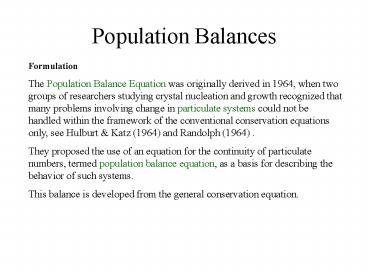Population Balances
1 / 2
Title: Population Balances
1
Population Balances
Formulation The Population Balance Equation was
originally derived in 1964, when two groups of
researchers studying crystal nucleation and
growth recognized that many problems involving
change in particulate systems could not be
handled within the framework of the conventional
conservation equations only, see Hulburt Katz
(1964) and Randolph (1964) . They proposed the
use of an equation for the continuity of
particulate numbers, termed population balance
equation, as a basis for describing the behavior
of such systems. This balance is developed from
the general conservation equation.
2
Population Balances (2)
Doraiswami Ramkrishna, Purdue University, West
Lafayette, Indiana, U.S.A. Population Balances.
Theory and Applications to Particulate Systems in
Engineering, Academic Press, ISBN
0-12-576970-9, Pages 355, Publication Date 8
August 2000, Price 83.99 Contents Foreword.
Preface. Introduction. The Framework of
Population Balances. Birth and Death Functions.
The Solution of Population Balance Equations.
Similarity Behavior of Population Balance
Equations. Inverse Problems in Population
Balances. The Statistical Foundation of
Population Balances. Index. Description Populati
on balances are of key relevance to a very
diverse group of scientists, including
astrophysicists, high-energy physicists,
geophysicists, colloid chemists, biophysicists,
materials scientists, chemical engineers, and
meteorologists. Chemical engineers have put
population balances to most use, with
applications in the areas of crystallization
gas-liquid, liquid-liquid, and solid-liquid
dispersions liquid membrane systems fluidized
bed reactors aerosol reactors and microbial
cultures































